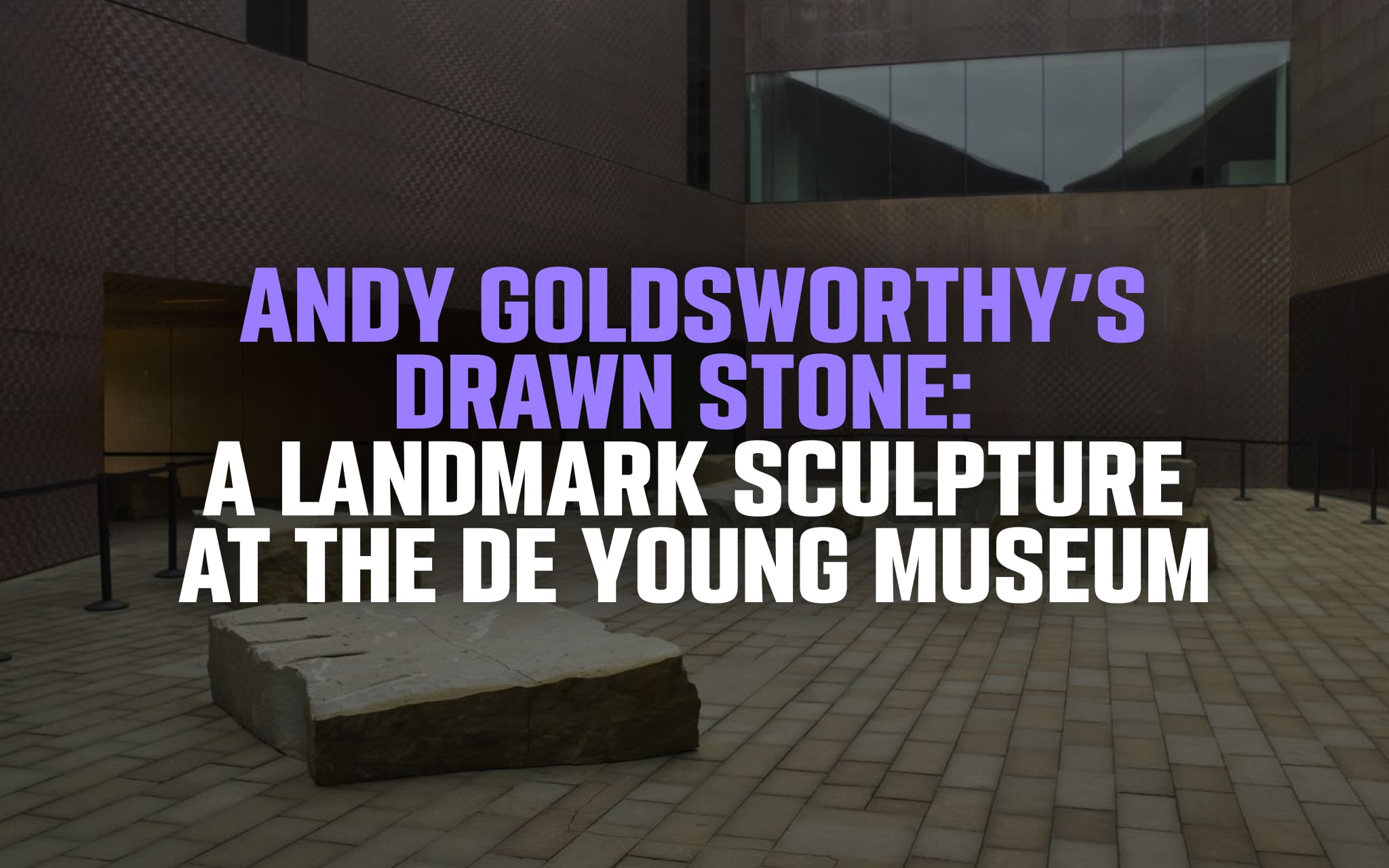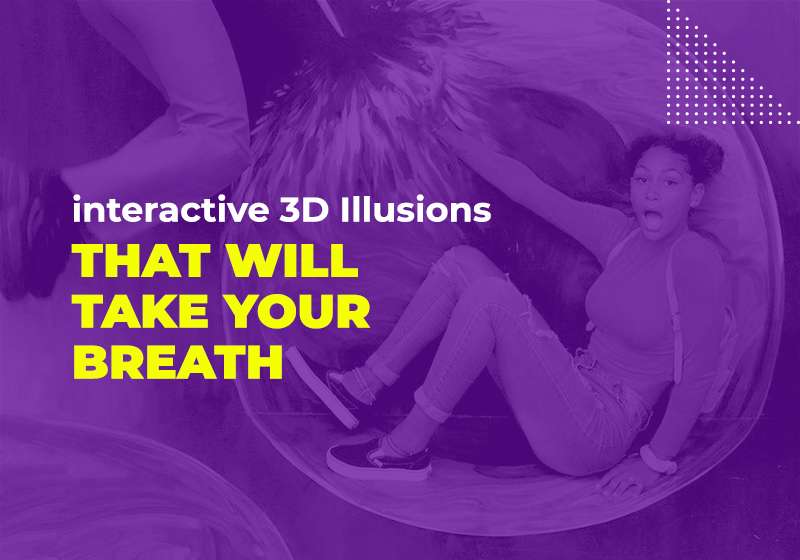
A jagged fissure runs through the sandstone courtyard of the De Young Museum, and it immediately seizes the imagination of anyone who pauses to notice it. Known as Drawn Stone, this striking installation by Andy Goldsworthy transforms a simple crack into a profound meditation on the forces that shape California. Its placement at the threshold of the De Young Museum ensures that visitors encounter it as both sculpture and experience before ever stepping inside.
Goldsworthy’s Drawn Stone is not an accident of nature but a deliberate act of creation. The artist intentionally split massive sandstone blocks with a hammer to create a crack that winds unpredictably across the courtyard. In doing so, he mimicked the restless energy of seismic fault lines, making the sculpture a permanent reminder of the fragile earth beneath San Francisco. It reflects how art can distill something as immense as geology into a tactile, human-scale form.
By choosing the courtyard of the De Young Museum for this piece, Andy Goldsworthy gave his work a setting steeped in history and renewal. The museum itself had been rebuilt following the devastation of the 1989 Loma Prieta earthquake, making Drawn Stone a fitting tribute to both rupture and resilience. Visitors encounter not only a museum but also a scar that acknowledges the earth’s capacity for sudden change.
Materials, Method, and Meaning
The sandstone that forms Drawn Stone was imported from Appleton Quarry in Yorkshire, a place near Andy Goldsworthy’s childhood home. This material choice connects two landscapes: the quiet quarries of England and the fault-ridden earth of California. It creates a dialogue between permanence and impermanence, as solid slabs are marked by fragile fractures that seem to threaten their stability.
Goldsworthy’s method of creating the crack reflects his broader philosophy. Rather than relying on machinery, he used hammer strikes to produce an organic fracture, one that refused predictability. The result is not a sterile cut but a living line that twists and turns, capturing the unpredictability of natural forces. It emphasizes that art, like geology, resists total control.
The symbolism embedded in Drawn Stone extends beyond material and method. The journey of the stone from England to San Francisco mirrors human movement across continents, while the fracture inscribed upon it recalls the shifts of tectonic plates. In this way, the installation becomes a meditation on both migration and disruption, forces that continually shape societies and landscapes alike.
Spatial Experience and Visitor Interaction
To walk across the courtyard of the De Young is to be drawn into the path of Drawn Stone. The crack originates from the roadway near the Music Concourse and snakes toward the museum entrance, guiding footsteps and eyes alike. It is not a separate monument but a feature that reshapes how visitors experience the space.
The installation’s slabs double as seating, making them quietly functional even as they carry deep symbolism. People rest upon them, often unaware they are part of a major work of art. This integration blurs the line between daily use and artistic contemplation, showing how Goldsworthy’s vision transforms ordinary movement into part of the artwork itself.
Many visitors may pass without realizing the crack is intentional, which is precisely its quiet strength. Drawn Stone thrives on subtlety: it does not demand attention but rewards it. Those who pause to notice find themselves caught between art and geology, between calm stone surfaces and the reminder of instability beneath San Francisco’s soil.
Earth-Shattering Concept in Stone
At its core, Drawn Stone is about California’s seismic identity. The fracture etched across its slabs evokes fault lines that crisscross the state, from the San Andreas to lesser-known fractures beneath the Bay Area. Andy Goldsworthy transforms that geological reality into a visible scar, allowing visitors to confront the unseen forces shaping their world.
The piece was originally titled “Faultline,” but Goldsworthy later renamed it Drawn Stone. The shift in title speaks to the artist’s sensitivity, moving from something overtly scientific to something more poetic and interpretive. The crack becomes not only a symbol of rupture but also a line drawn across history, nature, and architecture.
This fusion of art and geology underscores a broader truth: stone, which we so often see as solid and eternal, is itself vulnerable to disruption. By splitting slabs of sandstone, Andy Goldsworthy captures the paradox of permanence undone by sudden force. In San Francisco, where earthquakes remain part of daily awareness, the meaning resonates all the more powerfully.
Context: Artist and Architectural Setting
Andy Goldsworthy is celebrated worldwide for using natural materials to craft art that reveals patterns of change and decay. From icicles fused into fragile arches to leaves arranged in fleeting spirals, his work often embraces impermanence. Yet Drawn Stone stands apart as one of his enduring commissions, anchoring his philosophy in a permanent public setting.
The De Young Museum’s rebuilding in 2005 created an opportunity for site-specific artworks that reflected resilience after disaster. Goldsworthy’s crack in stone aligned seamlessly with this vision, complementing the angular design of Herzog & de Meuron’s architecture. Where the building speaks of renewal, Drawn Stone speaks of fragility, together forming a complete dialogue.
For visitors, the pairing of art and architecture intensifies the experience of place. The museum offers collections of American art spanning centuries, but even before entering, one encounters a work that addresses the ground itself. In a city shaped by earthquakes, this union of building and sculpture ensures that geology and culture are inseparably bound.
Immersive Perspective at the Museum of 3D Illusions
After contemplating the real fracture carved into sandstone at the De Young, visitors may be drawn to a nearby San Francisco attraction that plays with perception in a very different way. The Museum of 3D Illusions takes the solidity of walls and floors and turns them into gateways of imagination, transforming how people interact with space.
Inside, guests find themselves in surreal scenarios captured in vivid three-dimensional art. One might dangle from the edge of a skyscraper’s rooftop, testing nerves against the illusion of dizzying height. In another space, twisted car wrecks appear frozen mid-motion, allowing visitors to step into chaos without danger. These illusions invite physical participation, with photography encouraged to immortalize the playful encounters.
The venue also houses “Smash It!,” where creativity takes a cathartic turn. Visitors decorate plates with thoughts or drawings, then shatter them in a safe environment, channeling energy and emotion into the act of breaking. Together, the Museum of Illusions and Smash It! create an immersive companion to Drawn Stone: where Goldsworthy reveals the fractures of the earth, these experiences reveal the fractures of perception and emotion.
FAQ
Why did Andy Goldsworthy create Drawn Stone with a crack in the slabs?
Andy Goldsworthy designed Drawn Stone by splitting sandstone slabs with a hammer to echo the unpredictable fault lines of California. The fractured stone represents the earth’s shifting energy, transforming geology into art and reminding visitors of the natural instability beneath San Francisco.
How does Drawn Stone compare to interactive art experiences in San Francisco?
While Andy Goldsworthy’s Drawn Stone at the De Young Museum emphasizes quiet reflection on earthquakes and stone, the Museum of 3D Illusions offers a contrasting, playful experience. Visitors can immerse themselves in fantastical 3D scenes and interactive exhibits, engaging with perception rather than geology.


